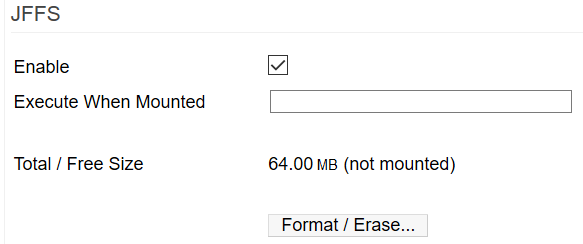User Tools
Sidebar
This is an old revision of the document!
Broadcom routers come with two important storage types:
FLASH - This is where your tomato firmware image is uploaded, stored and executed. At boot time, the image is loaded into a squash filesystem which mean it's executed read-only. Flash size is measured in Megabytes (MB).
NVRAM - This is where the configuration is stored. While loading the firmware from the squash filesystem, parameters in the form of variables are fetched from the NVRAM. NVRAM size is relatively small and is measured in Kilobytes KB.
Since modern routers have a relatively large amount of FLASH memory available, Tomato can mount the unused storage and make it available to Tomato's underlying (Linux) OS for normal file storage operations. This function is called JFFS.
The figures below are an example and don't scale properly. They will vary based on your Tomato version and your hardware specifications/features. See the HW compatibility page for more information on specific FLASH and NVRAM specifications.

Enable: Checking this box enables JFFS, as shown in the image image below.
Execute when mounted: In this field, you can enter the name of a script or similar to burn immeidately after the partition becomes available to Tomato.
Total / Free Size displays the storage size/usage. The size is not configurable.
Format / Erase: The very first time you enable JFFS you must format the partition. Once done the (not mounted) should turn into (mounted)
Once JFFS is mounted it can be accessed in the filesystem under the root folder /jffs

NOTE: You will not be able to upgrade FreshTomato if a JFFS partition is mounted, if you do disable JFFS and upgrade FreshTomato you'll lose the content so a backup/restore operation is needed.
Very important: Flash storage is not meant for frequent write operations hence you must avoid constant writes into it e.g. storing the logs in JFFS is a really bad idea at it will shorten your router life. Limitation is the writes but not the reads so e.g. an entware installation would be totally ok instead. Beaware of your JFFS, it should be used only if no other storage like USB or CIFS is available.
